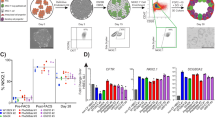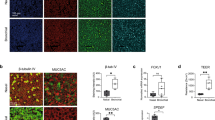Abstract
Cystic fibrosis (CF) is a fatal genetic disease caused by mutations in the CFTR (cystic fibrosis transmembrane conductance regulator) gene, which regulates chloride and water transport across all epithelia and affects multiple organs, including the lungs. Here we report an in vitro directed differentiation protocol for generating functional CFTR-expressing airway epithelia from human embryonic stem cells. Carefully timed treatment by exogenous growth factors that mimic endoderm developmental pathways in vivo followed by air-liquid interface culture results in maturation of patches of tight junction–coupled differentiated airway epithelial cells that demonstrate active CFTR transport function. As a proof of concept, treatment of CF patient induced pluripotent stem cell–derived epithelial cells with a small-molecule compound to correct for the common CF processing mutation resulted in enhanced plasma membrane localization of mature CFTR protein. Our study provides a method for generating patient-specific airway epithelial cells for disease modeling and in vitro drug testing.
This is a preview of subscription content, access via your institution
Access options
Subscribe to this journal
Receive 12 print issues and online access
$209.00 per year
only $17.42 per issue
Buy this article
- Purchase on Springer Link
- Instant access to full article PDF
Prices may be subject to local taxes which are calculated during checkout




Similar content being viewed by others
References
Van Haute, L., De Block, G., Liebaers, I., Sermon, K. & De Rycke, M. Generation of lung epithelial-like tissue from human embryonic stem cells. Respir. Res. 10, 105 (2009).
Samadikuchaksaraei, A. et al. Derivation of distal airway epithelium from human embryonic stem cells. Tissue Eng. 12, 867–875 (2006).
Wang, D., Haviland, D.L., Burns, A.R., Zsigmond, E. & Wetsel, R.A. A pure population of lung alveolar epithelial type II cells derived from human embryonic stem cells. Proc. Natl. Acad. Sci. USA 104, 4449–4454 (2007).
Mou, H. et al. Generation of multipotent lung and airway progenitors from mouse ESCs and patient-specific cystic fibrosis iPSCs. Cell Stem Cell 10, 385–397 (2012).
Kimura, J. & Deutsch, G.H. Key mechanisms of early lung development. Pediatr. Dev. Pathol. 10, 335–347 (2007).
Zorn, A.M. & Wells, J.M. Vertebrate endoderm development and organ formation. Annu. Rev. Cell Dev. Biol. 25, 221–251 (2009).
D'Amour, K.A. et al. Efficient differentiation of human embryonic stem cells to definitive endoderm. Nat. Biotechnol. 23, 1534–1541 (2005).
Ameri, J. et al. FGF2 specifies hESC-derived definitive endoderm into foregut/midgut cell lineages in a concentration-dependent manner. Stem Cells 28, 45–56 (2010).
Serls, A.E., Doherty, S., Parvatiyar, P., Wells, J.M. & Deutsch, G.H. Different thresholds of fibroblast growth factors pattern the ventral foregut into liver and lung. Development 132, 35–47 (2005).
Bellusci, S. et al. Involvement of Sonic hedgehog (Shh) in mouse embryonic lung growth and morphogenesis. Development 124, 53–63 (1997).
Kim, S.K. & Melton, D.A. Pancreas development is promoted by cyclopamine, a hedgehog signaling inhibitor. Proc. Natl. Acad. Sci. USA 95, 13036–13041 (1998).
Pan, Q. et al. In vivo characterization of the Nkx2.1 promoter/enhancer elements in transgenic mice. Gene 331, 73–82 (2004).
Bellusci, S., Grindley, J., Emoto, H., Itoh, N. & Hogan, B.L. Fibroblast growth factor 10 (FGF10) and branching morphogenesis in the embryonic mouse lung. Development 124, 4867–4878 (1997).
Shiratori, M. et al. Keratinocyte growth factor and embryonic rat lung morphogenesis. Am. J. Respir. Cell Mol. Biol. 15, 328–338 (1996).
Morrisey, E.E. & Hogan, B.L. Preparing for the first breath: genetic and cellular mechanisms in lung development. Dev. Cell 18, 8–23 (2010).
Weaver, M., Yingling, J.M., Dunn, N.R., Bellusci, S. & Hogan, B.L. Bmp signaling regulates proximal-distal differentiation of endoderm in mouse lung development. Development 126, 4005–4015 (1999).
Desai, T.J. et al. Distinct roles for retinoic acid receptors alpha and beta in early lung morphogenesis. Dev. Biol. 291, 12–24 (2006).
Metzler, M.D. & Snyder, J.M. Retinoic acid differentially regulates expression of surfactant-associated proteins in human fetal lung. Endocrinology 133, 1990–1998 (1993).
Whitsett, J.A. et al. Fibroblast growth factor 18 influences proximal programming during lung morphogenesis. J. Biol. Chem. 277, 22743–22749 (2002).
Rock, J.R. et al. Basal cells as stem cells of the mouse trachea and human airway epithelium. Proc. Natl. Acad. Sci. USA 106, 12771–12775 (2009).
Hong, K.U., Reynolds, S.D., Watkins, S., Fuchs, E. & Stripp, B.R. In vivo differentiation potential of tracheal basal cells: evidence for multipotent and unipotent subpopulations. Am. J. Physiol. Lung Cell. Mol. Physiol. 286, L643–L649 (2004).
Minoo, P. et al. Physical and functional interactions between homeodomain NKX2.1 and winged helix/forkhead FOXA1 in lung epithelial cells. Mol. Cell. Biol. 27, 2155–2165 (2007).
Davies, J.R., Kirkham, S., Svitacheva, N., Thornton, D.J. & Carlstedt, I. MUC16 is produced in tracheal surface epithelium and submucosal glands and is present in secretions from normal human airway and cultured bronchial epithelial cells. Int. J. Biochem. Cell Biol. 39, 1943–1954 (2007).
Huang, T.H. et al. Control of keratin gene expression by vitamin A in tracheobronchial epithelial cells. Am. J. Respir. Cell Mol. Biol. 10, 192–201 (1994).
Ratjen, F. & Doring, G. Cystic fibrosis. Lancet 361, 681–689 (2003).
Hotta, A. et al. EOS lentiviral vector selection system for human induced pluripotent stem cells. Nat. Protoc. 4, 1828–1844 (2009).
Kim Chiaw, P., Wellhauser, L., Huan, L.J., Ramjeesingh, M. & Bear, C.E. A chemical corrector modifies the channel function of F508del-CFTR. Mol. Pharmacol. 78, 411–418 (2010).
Lewis, H.A. et al. Impact of the deltaF508 mutation in first nucleotide-binding domain of human cystic fibrosis transmembrane conductance regulator on domain folding and structure. J. Biol. Chem. 280, 1346–1353 (2005).
Van Goor, F. et al. Correction of the F508del-CFTR protein processing defect in vitro by the investigational drug VX-809. Proc. Natl. Acad. Sci. USA 108, 18843–18848 (2011).
Wright, F.A. et al. Genome-wide association and linkage identify modifier loci of lung disease severity in cystic fibrosis at 11p13 and 20q13.2. Nat. Genet. 43, 539–546 (2011).
Trinh, N.T., Prive, A., Maille, E., Noel, J. & Brochiero, E. EGF and K+ channel activity control normal and cystic fibrosis bronchial epithelia repair. Am. J. Physiol. Lung Cell. Mol. Physiol. 295, L866–L880 (2008).
Sood, R. et al. Regulation of CFTR expression and function during differentiation of intestinal epithelial cells. EMBO J. 11, 2487–2494 (1992).
Acknowledgements
We would like to thank S. Yamanaka (CiRA, Kyoto, Japan) and A. Nagy (Samuel Lunenfeld Research Institute, Toronto, Ontario, Canada) for providing human iPSC lines (201B7, 253G1 and PB-4Fout, respectively). We would also like to thank R. Bridges (Rosalind Franklin University, Chicago) who provided the C18 analog. This work was funded by an Emerging Team grant from the Canadian Institutes of Health Research (GPG-102171) to C.E.B., F.R., J.E. and J.R. This work was supported (in part) by an Ontario Ministry of Economic Development and Innovation (MEDI) grant. A.P.W. was a recipient of the MEDI Post-doctoral Award. Monoclonal CFTR antibodies #450 and #660 were courtesy of J.R. Riordan (University of North Carolina, Chapel Hill, North Carolina, USA). CA1, CA2 hESC were obtained from A. Nagy (Mount Sinai Hospital, Toronto, Canada). H9 hESC were obtained from The WiCell Research Institute (Wisconsin, USA).
Author information
Authors and Affiliations
Contributions
A.P.W., J.R., J.E., C.E.B. and F.R. conceived the study and experimental design. A.P.W. performed and analyzed experiments and wrote the manuscript. C.E.B., P.P., T.O.T., L.-J.H., S.C. and F.R. provided reagents, conceptual and/or technical support in generating iPSC lines, doing the teratoma assay and making iodide efflux measurements. All authors edited and approved the final manuscript.
Corresponding authors
Ethics declarations
Competing interests
The authors declare no competing financial interests.
Supplementary information
Supplementary Text and Figures
Supplementary Figures 1–14 and Supplementary Tables 1–3 (PDF 2223 kb)
Rights and permissions
About this article
Cite this article
Wong, A., Bear, C., Chin, S. et al. Directed differentiation of human pluripotent stem cells into mature airway epithelia expressing functional CFTR protein. Nat Biotechnol 30, 876–882 (2012). https://doi.org/10.1038/nbt.2328
Received:
Accepted:
Published:
Issue Date:
DOI: https://doi.org/10.1038/nbt.2328
This article is cited by
-
From cells to organs: progress and potential in cartilaginous organoids research
Journal of Translational Medicine (2023)
-
Human disease models in drug development
Nature Reviews Bioengineering (2023)
-
Alveolar epithelial-like cell differentiation in a dynamic bioreactor: a promising 3D-approach for the high-throughput generation of lung cell types from human induced pluripotent stem cells
In vitro models (2023)
-
Harnessing three-dimensional (3D) cell culture models for pulmonary infections: State of the art and future directions
Naunyn-Schmiedeberg's Archives of Pharmacology (2023)
-
Regenerative medicine: current research and perspective in pediatric surgery
Pediatric Surgery International (2023)



